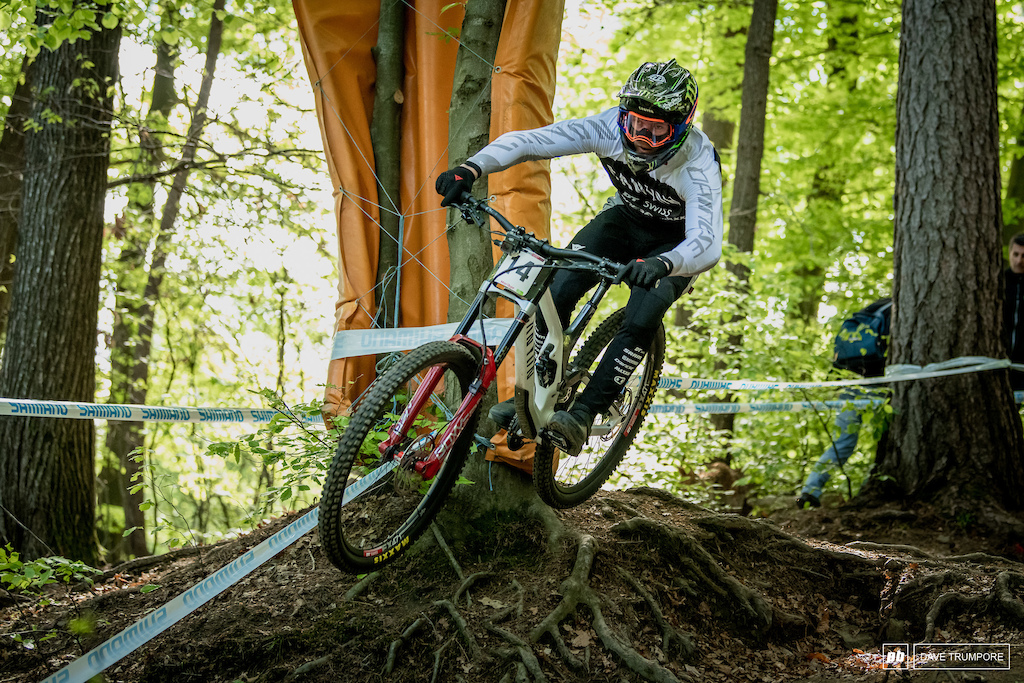How Do Coaches Help Riders Go Faster on a World Cup Weekend?
Words: Alan Milway
World Cup racing is a sport of very fine margins. To think that 50 riders were separated by just 10 seconds across 1.9km of technical terrain in Maribor shows that the more we can understand the ‘problem’ of racing across these tracks, try and quantify the challenge, and make adjustments and train for this, the better we will be prepared come race day.
Riders are being more open about their preparation away from the track and, as the videos and photo coverage shows from Slovenia, there is more openness about bike set up and analysis on track.
So how do the riders, teams and coaches understand the challenge of preparing bike and rider for a race run?
1. Go Pro footage
Helmet cameras are a vital training aid for riders, and they will all wear them to record runs and then review after. It helps them learn the track, compare line choice and spot new lines developing. Some of the bigger teams also have large TV monitors upstairs in the truck to review footage, and with simple screen splitting you can compare line choice and time through a section.
Having other film footage is also very useful and it can be used to compare different riders, different lines and also show conditions on track at that point – so a woman or Junior in B practice can show their footage to an Elite in A practice for them to see how the track is, before they head up for their practice. All very useful in bike set up and mental preparedness.
2. Coaches and Team on track
The teams all have staff on track to look at various sections and feedback on line choice. Comparing riders, line selection, and also bike set up. I spend a lot of time on track watching the riders and also filming with an iPad and iPhone to feedback to the riders to aid them. This can reduce time taken to get on to the best line choice and up to speed.
What is interesting though is that one line isn’t necessarily the best for all. A small light rider such as Danny or Troy may choose to ride a different line than one of the bigger, heavier riders as they may be able to slow to get up on to an inside line, instead of attacking an outside line. Take a look at brook MacDonald who surprised a lot of people in Maribor by electing to stay wide all the way around the rock garden and hold consistent speed down to the fireroad. He ended up being sixth fastest through that split, his best of the race, and fastest through the speed trap that was placed on the fireroad.
There is also risk versus reward in line choice - a consistent line might be chosen especially if conditions are changeable. Why risk an off-camber corner that is hard in the dry if the rain is due for race runs anyway? Team radios are a good link from the hill to the pits, and ultimately if the rider has all the info available they can make the best choice with advice from others.
3. Telemetry on the rider
Understanding the physical demands upon the rider is vital to help coaches such as myself prepare the riders for the challenge of racing. What is the rider going through and what do we need to prepare for?
I have linked riders up with heart rate monitors and GPS systems such as Garmin computers for years now so I can build up a picture up of various lengths of track and heart rates achieved. It is always fascinating but the best track data I’ve seen so far was Danny Harts timed qualifying run at Champery. To see the steepness of the track on the graph versus a heart rate of over 200bpm was extraordinary.

Heart rate data from Danny Hart's run at the Champery World Champs - The data selection starts before the run starts, and ends after the run has finished - and his average is 197bpm. His max was 207bpm which was higher than I had seen in any fitness assessment. The steep slope is altitude and the jagged spikes are speed.
Ultimately heart rates are close to or above the maximum you are likely to see in testing, and one error often made is to take these efforts and assume all training has to be done at these for the same durations. Human physiology is more complex than this and needs a different approach – although there is certainly a place for very hard, fatiguing efforts!
More recently, power cranks have been used and are a good insight in to the power, duration and frequency of pedalling on a track. Start gate power is obviously important, but knowing if and when riders have to lay down high power outputs is also very useful for training - the flat fire road section in Maribor is a good example of this.
What is better- out of the saddle pedalling, or tuck and draft for aero and energy saving? There is an interesting link between the two… The problem with power cranks is the limited info you gain when a rider isn’t pedalling- large gaps imply that nothing is happening through the pedals as the cranks aren’t rotating, but as you know this is misleading.
Accelerometers are therefore a very useful next step. They are the little boxes seen between the shoulder blades of rugby players - or any field sport for that matter. The data shows the heart rate, speed and also acceleration/deceleration of the rider and ultimately the load upon them. Where are the peak loads on track, and are we preparing appropriately for them?
I’ve measured peak G’s of between 6-8G on the rider in Andorra. Peak accelerations through the bike will be even higher than this due to the weight of the bike, and the data seems to support this. This could be explained by the equation force = mass * acceleration. So by changing this equation around to give acceleration, acceleration = force/mass. With a lower mass bike and higher mass rider seeing the same force, the bike will measure a higher G as it is lighter.
I’ve used this kit for a number of years to also try and understand the differences between elite males, elite females and junior racers. Where are the traces similar or different? Can we improve the trace of a junior to mirror an elite? And what needs to be done to achieve this. Also, is the difference in run time between the males and females shown in the forces through them – could a female ride faster if they could tolerate more load? These are just some of the questions you can attempt to answer with this data.
4. Telemetry on the bike
This has been around motorsport for years, and is gradually increasing in its use within downhill. Monitoring the suspension action, use of travel and rate of change of travel will all help the mechanics set up the bike to improve performance. It also helps back up the feedback from the rider and will drastically improve the time taken to get on to an optimum set up.
New systems are now available to link with brake pressure to show where a rider is braking (any comfort braking or dragging through an apex will be highlighted) and the new Stendec system can now be left on the bike permanently and is actually linked with a camera to show exactly where the data points link with position on track. Canyon’s Mark Wallace actually has two race bikes – one with data that is used for every practice run, and then a mirror race bike where the adjustments are made and then raced on (all shocks are dyno matched so exact copies). Very clever stuff.
5. Rider Feedback
Perhaps with all this technology and data it is easy to forget the most important factor in all of this; the rider. Ultimately, all of the staff, trucks, technicians and coaches arrive at a World Cup to help a rider achieve their full potential, and a happy rider, a relaxed rider and a supported rider will be the fastest. So don’t forget that sometimes simply taking five minutes to sit down with them, and say ‘feeling good up there?’ is the best feedback you are likely to need.
Alan Milway is the coach of a number of World Cup riders including Joe Smith, Joe Breeden, Mike Jones and Brendan Fairclough. Follow him here.
Author Info:
Must Read This Week
Sign Up for the Pinkbike Newsletter - All the Biggest, Most Interesting Stories in your Inbox
PB Newsletter Signup








 Member since Jul 22, 2013
Member since Jul 22, 2013
www.youtube.com/watch?v=1tSqSMOyNFE
That whole part about acceleration of the rider and the bike isn't right. That's...not how acceleration works. You measure acceleration of a body (bike, rider, airplane cockpit, whatever) with an accelerometer. "G"s (gravity) is a unit of acceleration. A bike experiencing more acceleration than the rider has nothing to do with the mass of the bike, it has to do with the dynamics of the whole system. If you were to place a little tracer dot on the rider and the bike and take images every small fraction of a second, you could calculate the acceleration of the rider and the bike graphically. A bike which is accelerating relative to the rider will have a different acceleration than the rider, like when the rider hits a bump and soaks it up with their arms and legs - the bike moves more than the rider, and thus it has a different acceleration.
Accelerometers actually use force (F=ma, everyone loves it), but they measure a very small element inside the sensor - typically a crystal. They don't measure force on the bike, unless you attached a strain gauge to the bike, but that's a completely different story.
You could use an accelerometer and the handy F=ma equation along with the mass of the bike to calculate gravitational forces the bike experiences, but those are of little concern compared to the other forces involved like rider input and suspension.
Cheers!
Thanks for putting it straight @shredteds